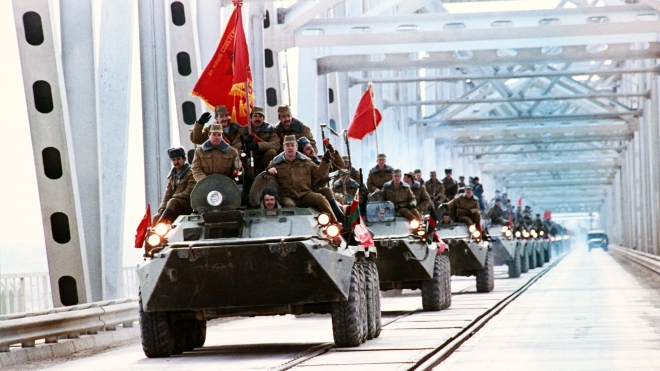In April 1978, the pro-communist Peopleʼs Democratic Party of Afghanistan organized a military coup against the monarchical regime and seized power in the country. In the photo: Celebration of the first anniversary of the "communist revolution" in Kabul, April 28, 1979.
Getty Images / «Babel'»
In 1979, the Islamic opposition launched an armed revolt against the communist regime in Afghanistan. One of the largest groups of insurgents was called the Mujahideen, from Arabic — participants of jihad, the holy war against the "infidels". In the photo: Mujahideen insurgents in Afghanistan, April 1979.
Getty Images / «Babel'»
Afghan communists quarreled with each other. In September 1979, the Defense Minister Hafizullah Amin removed Nur Mohammad Taraki from the seat of Secretary General of the NDP Central Committee, then executed him and arranged repression against Tarakiʼs supporters. In the photo: Portrait of the Secretary General of the NDP Central Committee Nur Mohammad Taraki (in the center) during the celebration of the first anniversary of the "communist revolution" in Kabul, on the left ― a portrait of Hafizullah Amin, April 27, 1979.
Getty Images / «Babel'»
It was Amin who asked the Soviet Union to send troops to Afghanistan. However, the Kremlin was dissatisfied with his tough policies and generally suspected that he was cooperating with the CIA. Therefore, in the first stage of the invasion, in December 1979, Soviet special forces stormed Aminʼs residence, he himself was killed in a shootout. In the photo: Soviet troops and equipment at Kabul airport at the beginning of the invasion of Afghanistan, December 29, 1979.
Getty Images / «Babel'»
After invasion and Aminʼs assassination, the Soviet Union put the more obedient Babrak Karmal as the leader of the Afghan Communists, and in 1986 he was replaced by the head of the Afghan KGB analog, Mohammad Najibullah. In the photo: President of Afghanistan Mohammad Najibullah (to the right from the microphones) during a military parade in Kabul in honor of Soviet-Afghan friendship, October 17, 1986.
Getty Images / «Babel'»
The Soviet leadership hoped to quickly quell the revolt in Afghanistan with a "limited contingent" of troops and to strengthen the power of the pro-Soviet regime, but did not take into account the local specifics and scale of resistance. Eventually, more military equipment and soldiers had to be sent to Afghanistan. In the photo: Soviet tanks on the street in the center of Kabul, January 8, 1981.
Getty Images / «Babel'»
Eventually, Soviet troops were embroiled in the Afghan war for more than nine years, and the "limited contingent" grew to about 100,000 troops. In the photo: Soviet soldiers in Kabul, August 16, 1988.
Getty Images / «Babel'»
Until about 1985, Soviet troops fought large-scale battles with the Mujahideen in Afghanistan, and then moved to support Afghan government troops with aircraft and artillery. In the photo: Soviet combat helicopter flies over the positions of Afghan government troops near Kabul, January 14, 1989.
Getty Images / «Babel'»
When Mikhail Gorbachev came to power in 1985, the Soviet Union began to gradually withdraw troops from Afghanistan. In the photo: Soviet soldier eating an orange on Kabul Street, April 25, 1988.
Getty Images / «Babel'»
The Afghan Mujahideen waged an effective guerrilla war against the vast majority of Soviet and government forces. They did not face direct clashes, but organized ambushes and sabotage and then retreated to fortified areas in the mountains. In the photo: Mujahideen carry mortar shells to the front from a fortified base in the mountains, February 10, 1988.
Getty Images / «Babel'»
In the photo: Mujahideen near a destroyed Soviet tank near the Afghan city of Jalalabad, March 1989.
Getty Images / «Babel'»
To prevent the Soviet Union from increasing its influence in the Middle East, the Mujahideen began to receive support from the United States, Pakistan, the UAE, Iran, China and other countries. They provided financial support and weapons. In the photo: Mujahideen with the American portable anti-aircraft missile system "Stinger", February 10, 1988. The supply of these weapons caused great damage to Soviet aircraft.
Getty Images / «Babel'»
The official loss of Soviet troops in Afghanistan is estimated at 15,000, with unofficial estimates around 30,000 Soviet soldiers have died there. The loss of Afghans, including civilians, is estimated at about two million. In the photo: Captive Soviet soldiers at the Mujahideen mountain camp, January 6, 1982.
Getty Images / «Babel'»
After the withdrawal of Soviet troops, the government army, despite the large number of military equipment, held out against the Mujahideen until the spring of 1992. The communist regime in Afghanistan fell, but the civil war continued. In the photo: Soviet paratroopers train soldiers of the Afghan government army, April 1988.
Getty Images / «Babel'»
After all, Soviet troops were unable to defeat the Mujahideen. The Afghan war was not only a political defeat for the Soviet leadership, but also one of the factors that led to the collapse of the Soviet Union. In the photo: People meet the last units of the Soviet army that left Afghanistan, in the city of Termez near the Uzbek-Afghan border, on February 16, 1989.
Getty Images / «Babel'»
Translated from Ukrainian by Yulia Pryimak .
We tell about historical events honestly and objectively. You can support Babel here .


